Written By: Sergio Harding
What We Learned
Through its extensive geographic breadth and scope, the Second Atlas provides a valuable, large-scale snapshot of the status of Virginia’s breeding avifauna. In addition, the changes in the composition of these bird communities over time can be assessed through a comparison with data reported some thirty years ago during the First Atlas.
The Second Atlas documented breeding evidence for 205 species. This included 196 species that were confirmed breeders, as well as four that were probable breeders and five that were possible breeders (Table 1). Each of these species except for Swallow-tailed Kite (Elanoides forficatus) and Northern Waterthrush (Parkesia noveboracensis) is profiled in a full Species Account, for a total of 203 Accounts.
Table 1. Species documented as probable or possible breeders during the Second Atlas. The highest breeding category for each species is also provided for the First Atlas. Species are sorted by status during the Second Atlas, then by taxonomic order.
| Common Name | Scientific Name | Second Atlas | First Atlas |
|---|---|---|---|
| Black Rail | Laterallus jamaicensis | probable | possible |
| Alder Flycatcher | Empidonax alnorum | probable | probable |
| Swainson’s Thrush | Catharus ustulatus | probable | probable |
| Pine Siskin | Spinus pinus | probable | confirmed |
| American Bittern | Botaurus lentiginosus | possible | confirmed |
| Swallow-tailed Kite | Elanoides forficatus | possible | not reported |
| Merlin | Falco columbarius | possible | not reported |
| Northern Waterthrush | Parkesia noveboracensis | possible | confirmed |
| Henslow’s Sparrow | Centronyx henslowii | possible | confirmed |
This editorial decision was made for Swallow-tailed Kite because it is not known to breed in the Commonwealth. However, there has been an increase in the number of spring and summer records for the species in Virginia’s Coastal Plain since the 1950s (Rottenborn and Brinkley 2007), which hints at the possibility of its nesting there. The kite also appears to be expanding its range northward, as it was documented nesting in North Carolina in 2013. It was documented in one block in Northampton County during the Second Atlas.
Northern Waterthrush likewise was not featured in a Species Account as it is considered a casual breeder in Virginia, with only one breeding confirmation on record (Rottenborn and Brinkley 2007); this confirmation was documented during the First Atlas. The species was documented in one block in Highland County during the Second Atlas.
Like Swallow-tailed Kite and Northern Waterthrush, three other species did not rise above the level of possible breeders during the Second Atlas; however, each was profiled in a Species Account. The American Bittern (Botaurus lentiginosus), though rare, is better established as a breeder in the Commonwealth than the waterthrush (Rottenborn and Brinkley 2007) and therefore merited a Species Account. This was also the case for the Henslow’s Sparrow (Centronyx henslowii), which was also confirmed as a breeder in the northern Piedmont in 2022. The Merlin (Falco columbarius), another possible breeder during the Second Atlas, was confirmed as a first-time breeder in Virginia in 2021, some months after the field data collection period had closed for the Second Atlas. Given the significance and timing of this record, this species was also featured in a Species Account.
New Breeding Species Since the First Atlas
Eight species that were not detected during the First Atlas were confirmed as breeders during (or shortly after) the Second Atlas. They include two new breeders to Virginia: Painted Bunting (Passerina ciris), whose breeding confirmation during the Second Atlas was the first breeding record for the state, and Merlin, which was first confirmed as a breeder in Virginia in 2021.
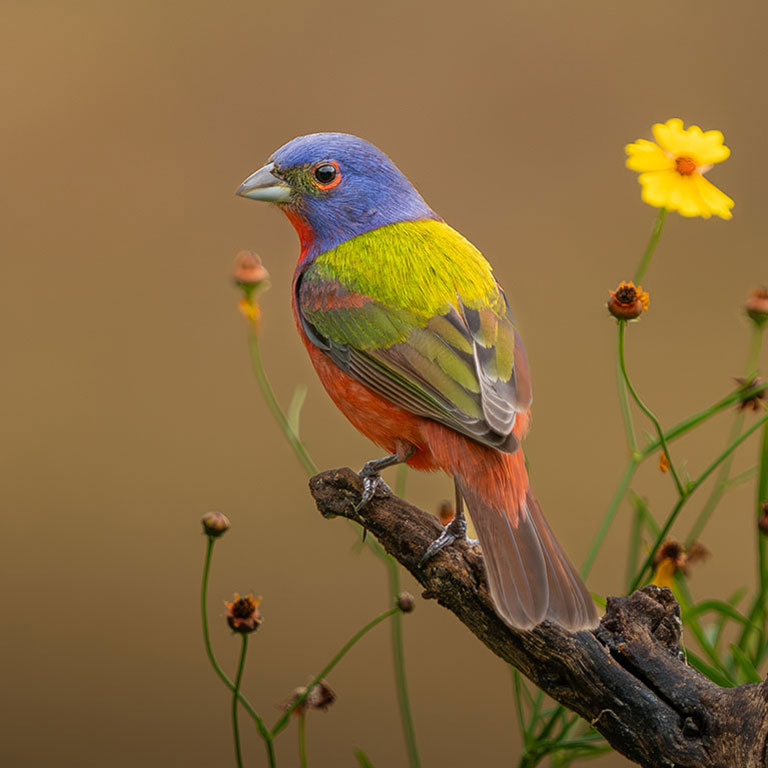
The remaining species had been confirmed as breeders in Virginia prior to the Second Atlas, and those details are available in their respective Species Accounts. They are the following: Anhinga (Anhinga anhinga), Black-necked Stilt (Himantopus mexicanus), Yellow-rumped Warbler (Setophaga coronata), Mississippi Kite (Ictinia mississippiensis), Eurasian Collared-Dove (Streptopelia decaocto) and Trumpeter Swan (Cygnus buccinator). The last two species are not native to Virginia, though Trumpeter Swans are reported to have wintered in areas of the Commonwealth during the 19th century. An additional species, the Common Merganser (Mergus merganser), bred historically in Virginia but was subsequently lost. It was reported without breeding evidence during the First Atlas, regaining its status as a breeder in the Commonwealth in the early 2000s (Rottenborn and Brinkley 2007). Virginia’s geographic position along the Mid-Atlantic coast contributes to a confluence of breeding species whose core ranges lie to the north or south of the Commonwealth. For example, of the species above, Anhinga, Mississippi Kite, and Eurasian Collared-Dove are new breeders since the First Atlas as a result of northward range expansions, and Merlin and Yellow-rumped Warbler are new breeders as a result of southward range expansions.
Species with Breeding Evidence During the First but not Second Atlas
Ten species were documented with breeding evidence during the First Atlas but not during the Second Atlas (Table 2). Three of these were not confirmed as breeders in the First Atlas. They include the following:
- Short-eared Owl (Asio flammeus), which is considered a casual breeder in Virginia based on its having bred regularly in low numbers in coastal salt marshes of the Coastal Plain region through the 1920s and irregularly in the northern Piedmont as recently as 2001 (Rottenborn and Brinkley 2007);
- Yellow-bellied Flycatcher (Empidonax flaviventris), which was known to breed on Mount Rogers in Grayson and Smyth Counties in the 1970s through the mid-1980s (Rottenborn and Brinkley 2007); and
- Nashville Warbler (Leiothlypis ruficapilla), which has never been confirmed as a breeder in the state but is suspected to have bred in the Mountains and Valleys region based on summer records and other evidence (Rottenborn and Brinkley 2007).
Table 2. Species documented with breeding evidence during the First Atlas but not during the Second Atlas. The highest breeding category for each species is provided. Species are sorted by status during the First Atlas, then by taxonomic order.
| Common Name | Scientific Name | First Atlas | Second Atlas |
|---|---|---|---|
| Blue-winged Teal | Spatula discors | confirmed | observed |
| Green-winged Teal | Anas crecca | confirmed | observed |
| Ring-necked Pheasant | Phasianus colchicus | confirmed | observed |
| Upland Sandpiper | Bartramia longicauda | confirmed | observed |
| Bewick’s Wren | Thryomanes bewickii | confirmed | not reported |
| Sedge Wren | Cistothorus stellaris | confirmed | observed |
| Bachman’s Sparrow | Peucaea aestivalis | confirmed | not reported |
| Short-eared Owl | Asio flammeus | probable | observed |
| Nashville Warbler | Leiothlypis ruficapilla | probable | observed |
| Yellow-bellied Flycatcher | Empidonax flaviventris | possible | observed |
The remaining seven species were confirmed breeders during the First Atlas (Table 2), and information about each is summarized below. Several additional species that have been known to breed in Virginia, including irregular breeders, were not reported with breeding evidence during either Atlas and are not addressed here. The publication “Virginia’s birdlife: An annotated checklist, 4th edition” (Rottenborn and Brinkley 2007) provides a comprehensive list of these species and their breeding status in the Commonwealth.

Blue-winged Teal
The Blue-winged Teal (Spatula discors) nests over a large swath of North America, reaching its highest densities in the prairies of the northern central U.S. and Canada (Rohwer et al. 2020). It breeds irregularly or in low numbers in many portions of its range, including the eastern states (Rohwer et al. 2020). In Virginia, it apparently never had a strong breeding presence. Here, it has been considered locally uncommon along coastal areas, where it nests in ponds and marshes, and rare further inland (Rottenborn and Brinkley 2007).
Blue-winged Teals were confirmed breeders in three blocks in the Coastal Plain during the First Atlas, in Accomack and Northampton Counties on the Eastern Shore and in a block crossing the city boundaries of Hampton and Poquoson on the Lower Peninsula (Trollinger and Reay 2001). Over 450 observations of Blue-winged Teals were reported during the Second Atlas, but none with breeding evidence. Although the species may still breed in small numbers in Virginia, previously known breeding habitats such as small offshore islands in the Chesapeake Bay have eroded away or have been reduced in both size and habitat suitability (Gary Costanzo, personal communication).
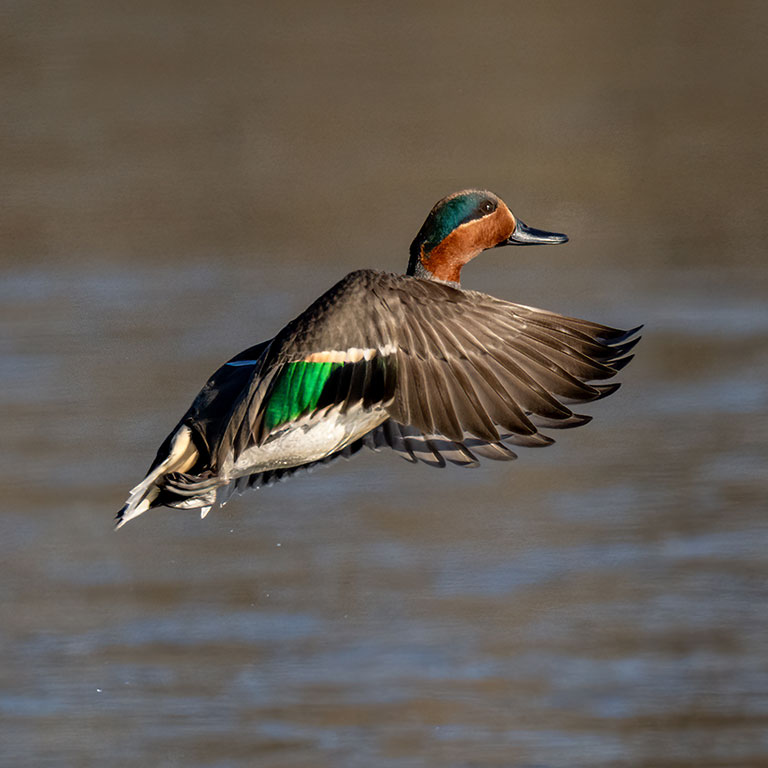
Green-winged Teal
The Green-winged Teal (Anas crecca) has a widespread, intercontinental breeding range (Johnson et al. 2020). In North America, it is represented by the subspecies A. c. carolinensis, which nests in Alaska and Canada and through portions of the Northwest, Upper Midwest, and Northeast (Johnson et al. 2020). It breeds irregularly outside of this core range and is considered a casual breeder in Virginia (Rottenborn and Brinkley 2007). During the First Atlas, the Green-winged Teal was a confirmed breeder in only one block in Smyth County in the Mountains and Valleys (Trollinger and Reay 2001). Although 330 individual observations of the species were documented during the Second Atlas, none were associated with breeding evidence. The species may still breed occasionally in Virginia (Gary Costanzo, personal communication).

Ring-necked Pheasant
The Ring-necked Pheasant (Phasianus colchicus) is a non-native species which, in Virginia, requires cultivated lands interspersed with heavy grasses and swampy bottoms (Marc Puckett, personal communication). It was introduced into the Commonwealth between 1958 (Taylor 1971) and at least 1976 (Rottenborn and Brinkley 2007) by the Virginia Department of Wildlife Resources (VDWR) to establish a population for hunting purposes. VDWR releases ended sometime in the 1970s (Marc Puckett, personal communication). Additional introductions by hunt clubs occurred as early as 1947 (Taylor 1971), and private releases on shooting preserves continue to this day.
The VDWR program used mostly hybrid birds produced from brood stock of several species and subspecies of pheasant, releasing them in multiple counties across all three physiographic regions (Taylor 1971). Although birds associated with several of the release events were able to breed successfully (Taylor 1971), habitat change may have ultimately prevented the birds from taking permanent hold on the Virginia landscape (Marc Puckett, personal communication). Ring-necked Pheasant was reported as a confirmed breeder in four blocks during the First Atlas, including in Rockbridge and Warren Counties in the Mountains and Valleys region and in New Kent (or Charles City) and York Counties in the Coastal Plain region (Trollinger and Reay 2001). Contemporary reports of the species are likely from continuing local introductions (Rottenborn and Brinkley 2007). Ring-necked Pheasant was documented through 11 observations without breeding evidence during the Second Atlas.
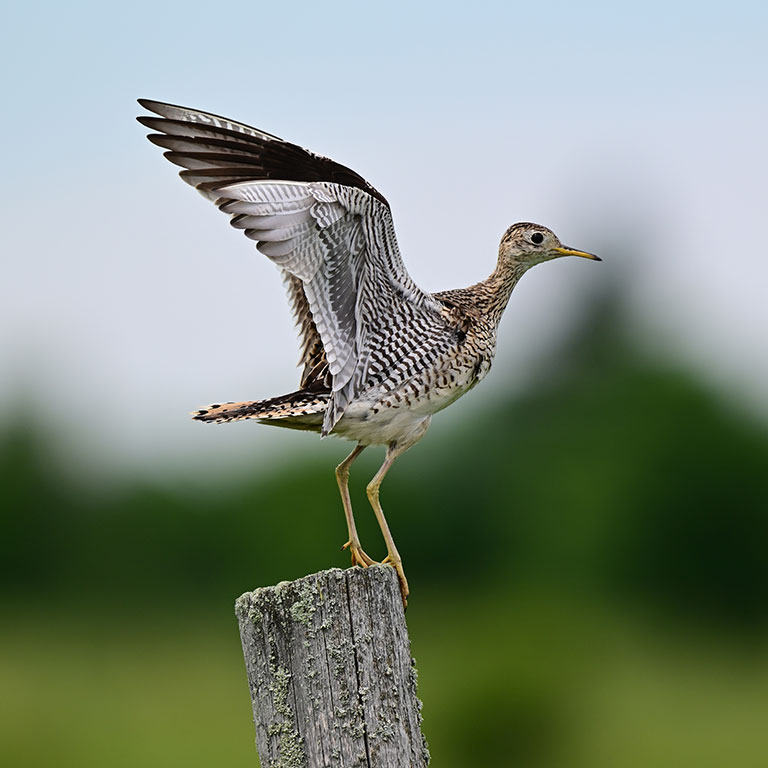
Upland Sandpiper
The Upland Sandpiper (Bartramia longicauda), a grassland-nesting shorebird of the Great Plains, expanded its range into the eastern U.S. during the extensive forest clearing of the 19th century (Wilson and Watts 2012). The eastern population subsequently crashed due to unregulated market hunting in the late 1800s and never recovered to its former levels (Houston et al. 2023). The species appears to have been extirpated as a breeder from many of the northeastern states by the 1990s (Houston et al. 2023).
Virginia’s population, at the southeastern edge of its breeding range, followed a similar trajectory. Here, Upland Sandpipers bred in the Piedmont and Mountains and Valleys regions, nesting in pastures and hayfields and in the grassy fields at airports (Wilson and Watts 2012). With the exception of the college farm at Virginia Tech in Montgomery County, where up to 20 breeding pairs were documented annually, most reports in the 1930s and 1940s were of only up to a few pairs (Wilson and Watts 2012).
The population continued to dwindle, and Upland Sandpipers were confirmed breeders in only four blocks during the First Atlas, where they were found in Fauquier and Loudoun Counties in the Piedmont region and Pulaski and Shenandoah Counties in the Mountains and Valleys region (Trollinger and Reay 2001). The species was last documented breeding in Virginia in 2002 at the Remington Turf Farm in Fauquier County (Rottenborn and Brinkley 2007). Five observations of Upland Sandpiper were reported during the Second Atlas for the months of April and August, but none with breeding evidence.
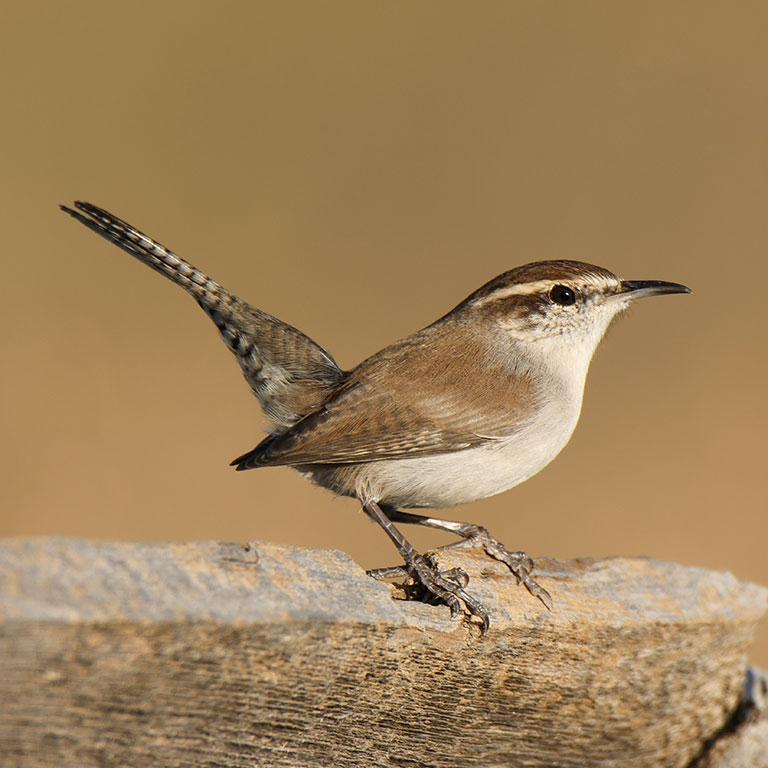
Bewick’s Wren
The Bewick’s Wren (Thryomanes bewickii) was once described as more common than both the Northern House Wren (Troglodytes aedon) and Carolina Wren (Thryothorus ludovicianus) (Lord 1949,Scott 1952) in parts of the Mountains and Valleys region, its historic stronghold in Virginia. This followed an expansion of its western U.S. breeding range into the eastern U.S. in the mid- to late-1800s, following the conversion of forests to agriculture (Kennedy and White 2020). A species of open, shrubby habitats (Kennedy and White 2020), it was described from farms and pastures in the Commonwealth (Grey and Stevens 1949, Lord 1949, Scott 1952).
In Virginia, it also bred in the Coastal Plain, where it was reported nesting in the Norfolk area in the late 1800s, and in multiple counties in the Piedmont (Rottenborn and Brinkley 2007). During the First Atlas, the Bewick’s Wren was confirmed as a breeder in only two blocks in Dickenson and Highland Counties in the Mountains and Valleys region (Trollinger and Reay 2001); the latter observation, from 1989, represents the last breeding record for the state (Rottenborn and Brinkley 2007). The Appalachian and broader eastern breeding population is functionally extirpated. The driving factor is believed to be competition with the Northern House Wren (Kennedy and White 2020), which underwent its own southward range expansion in the late 1800s (Johnson 2024). No observations of Bewick’s Wren were reported during the Second Atlas.
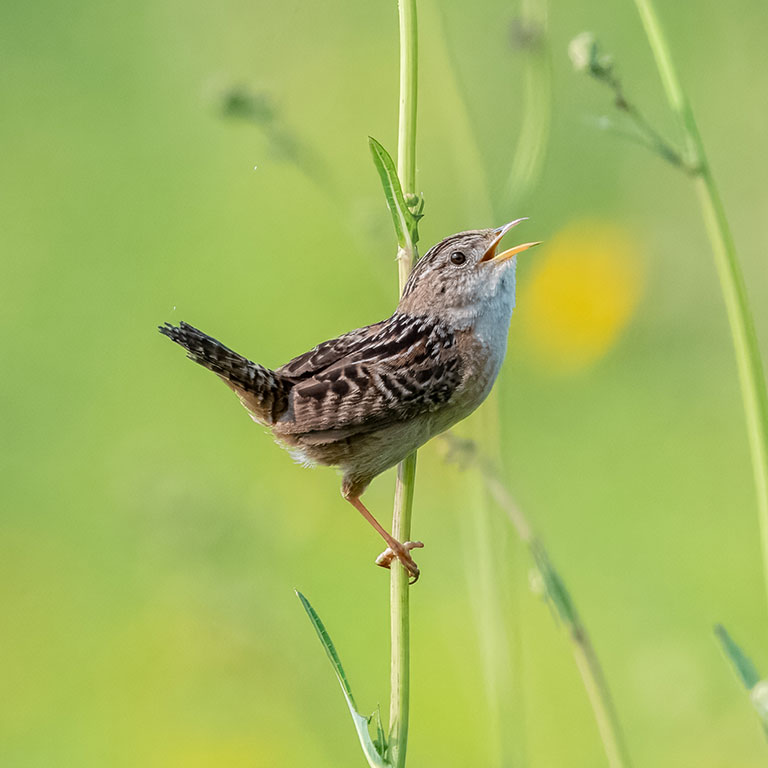
Sedge Wren
The Sedge Wren (Cistothorus stellaris) is associated with salt marshes in the Chesapeake Bay and may nest in a variety of grassland habitats elsewhere in its range (Wilson et al. 2007). It is considered a casual breeder occurring in low numbers in Virginia (Rottenborn and Brinkley 2007). Here, it is at the periphery of its core breeding range, which is in the upper Midwest and adjacent Canada and the northeastern states (Herkert et al. 2021). There are fewer than ten breeding confirmations of Sedge Wren in the Commonwealth. However, summer reports of singing birds across all three of Virginia’s physiographic regions (Rottenborn and Brinkley 2007) hint at more widespread, albeit sporadic, breeding. The species is considered a nomadic breeder, prone to erratic movements during the breeding season across its range (Herkert et al. 2021).
During the First Atlas, the Sedge Wren was a confirmed breeder in only one block in Accomack County on the Eastern Shore in the Coastal Plain region (Trollinger and Reay 2001). The last confirmed breeding record for Virginia was from Augusta County in 2004 (Rottenborn and Brinkley 2007). Fourteen observations of Sedge Wren were reported during the Second Atlas, but none with breeding evidence; based on the reported dates of observations, these were likely a mix of wintering (December and February) and spring (April and May) and fall (August) migrants.
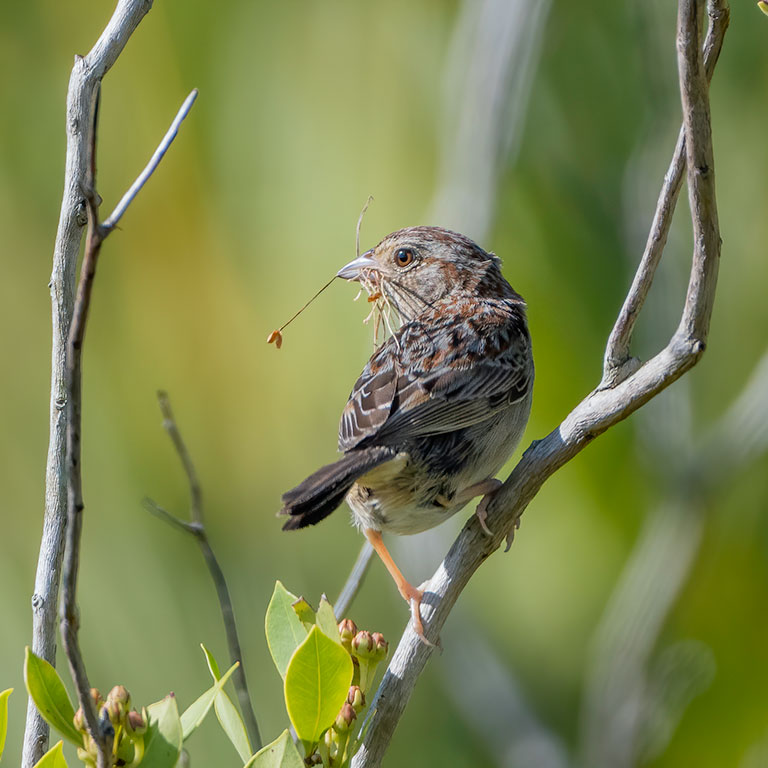
Bachman’s Sparrow
The Bachman’s Sparrow (Peucaea aestivalis) is a bird of mature, open pine savannas of the southeastern U.S. (Dunning et al. 2020). The species’ breeding range may have extended as far north as Virginia in pre-colonial times when such forests were present here. However, it was not documented in the Commonwealth until 1897 (Watts 2000). Bachman’s Sparrow was reported in the Mountains and Valleys region through 1948 and in the Piedmont region through 1968 (Rottenborn and Brinkley 2007). It was rediscovered in the Piedmont region in Brunswick County in 1986 during the First Atlas (Trollinger and Reay 2001) and was first documented in the Coastal Plain region in Sussex County in 1989 (Rottenborn and Brinkley 2007). It was subsequently found at Fort Pickett and Fort A.P. Hill in 1993, and singing males were recorded in regenerating clearcuts in southside Virginia in 1996 (Watts et al. 1998). This ephemeral habitat does not provide the long-term stability necessary to sustain populations of the species, and the sparrow was last reported in Virginia in 2003 from Suffolk County (Don Schwab, personal communication). Mature pine savannahs such as those found at The Nature Conservancy’s Piney Grove Preserve and VDWR’s Big Woods Wildlife Management Area in Sussex County are the best hope for reestablishment of the species in Virginia.
Literature Cited
Bailey, R. S., and C. B. Rucker (Editors) (2021). The second atlas of breeding birds in West Virginia. The Pennsylvania State University Press, University Park, PA, USA. 568 pp.
Dunning, J. B., Jr., P. Pyle, and M. A. Patten (2020). Bachman’s Sparrow (Peucaea aestivalis), version 1.0. In Birds of the World (P. G. Rodewald, Editor). Cornell Lab of Ornithology, Ithaca, NY, USA. https://doi.org/10.2173/bow.bacspa.01
Grey, J.H. and C.E. Stevens, Jr. (1949). The birds of Albemarle County, Virginia. The Raven 20:67–111.
Herkert, J. R., D. E. Kroodsma, and J. P. Gibbs (2021). Sedge Wren (Cistothorus stellaris), version 1.0. In Birds of the World (A. F. Poole and F. B. Gill, Editors). Cornell Lab of Ornithology, Ithaca, NY, USA. https://doi.org/10.2173/bow.sedwre1.01
Houston, C. S., S. G. Mlodinow, C. Jackson, D. E. Bowen Jr., and F. Medrano (2023). Upland Sandpiper (Bartramia longicauda), version 2.0. In Birds of the World (N. D. Sly, Editor). Cornell Lab of Ornithology, Ithaca, NY, USA. https://doi.org/10.2173/bow.uplsan.02
Johnson, K., C. Carboneras, D. A. Christie, and G. M. Kirwan (2020). Green-winged Teal (Anas crecca), version 1.0. In Birds of the World (S. M. Billerman, Editor). Cornell Lab of Ornithology, Ithaca, NY, USA. https://doi.org/10.2173/bow.gnwtea.01
Johnson, L. S. (2024). Northern House Wren (Troglodytes aedon), version 1.1. In Birds of the World (B. K. Keeney, A. F. Poole, M. G. Smith, and S. M. Billerman, Editors). Cornell Lab of Ornithology, Ithaca, NY, USA.
Kennedy, E. D. and D. W. White (2020). Bewick’s Wren (Thryomanes bewickii), version 1.0. In Birds of the World (A. F. Poole, Editor). Cornell Lab of Ornithology, Ithaca, NY, USA. https://doi.org/10.2173/bow.bewwre.01
Lord, W. (1949). Bird checklist – Blue Ridge Parkway – Rocky Knob District. The Raven 20:17–22.
Rottenborn, S. C. and E. S. Brinkley (Editors) (2007). Virginia’s birdlife: An annotated checklist. 4th edition. Virginia Society of Ornithology.
Rohwer, F. C., W. P. Johnson, and E. R. Loos (2020). Blue-winged Teal (Spatula discors), version 1.0. In Birds of the World (A. F. Poole and F. B. Gill, Editors). Cornell Lab of Ornithology, Ithaca, NY, USA. https://doi.org/10.2173/bow.buwtea.01
Scott, F.R. (1952). Notes on the Birds of Highland County, Virginia. The Raven 23:63–65.
Taylor, W.H. (1971). Foreign Game Bird Stockings and Results in Virginia. Journal of the Southeastern Association of Fish and Wildlife Agencies. 165–175. https://seafwa.org/journal/1971/foreign-game-bird-stockings-and-results-virginia.
Trollinger, J.B. and K.K. Reay (2001). Breeding Bird Atlas of Virginia 1985-1989, Virginia Department of Game and Inland Fisheries, Richmond, VA, USA. 219 pages.
Watts, B. D., M. D. Wilson, D. S. Bradshaw, and A. S. Allen (1998). A survey of the Bachman’s Sparrow in southeastern Virginia. The Raven 69:9–14.
Watts, B. D. (2000). Bachman’s Sparrow management plan: Fort A. P. Hill, Virginia. CCBTR-00-06. Center for Conservation Biology Technical Report Series. College of William and Mary, Williamsburg, VA, USA. 17 pp.
Wilson, A. M., D. W. Brauning and R. S. Mulvihill (Editors) (2012). Second atlas of breeding birds in Pennsylvania. The Pennsylvania State University Press, University Park, PA, USA. 612 pp.
Wilson, M. D., B. D. Watts, and D. F. Brinker (2007). Status review of Chesapeake Bay marsh lands and breeding marsh birds. Waterbirds 30:122–137.
Wilson, M. D., and B. D. Watts (2012). The Virginia avian heritage project: a report to summarize the Virginia avian heritage database. Center for Conservation Biology Technical Report Series, CCBTR 12-04. College of William and Mary and Virginia Commonwealth University. Williamsburg, VA, USA. 48 pp.
